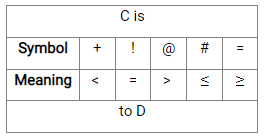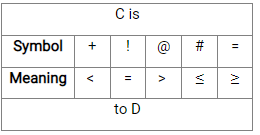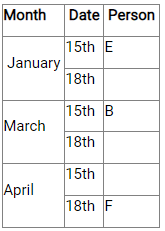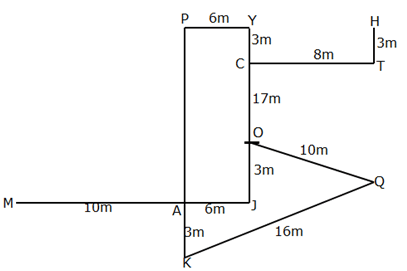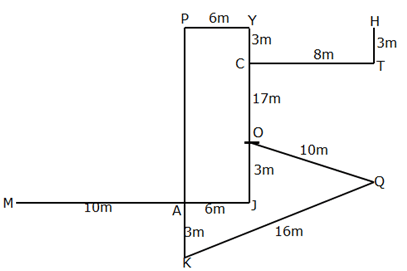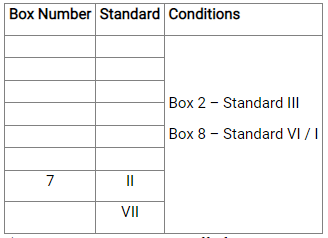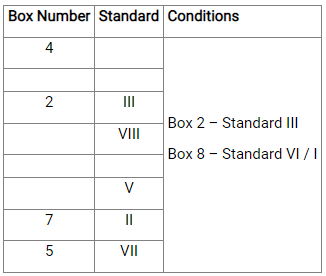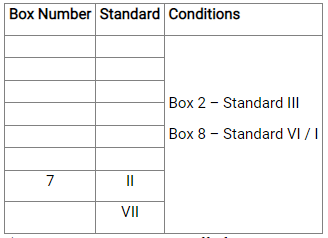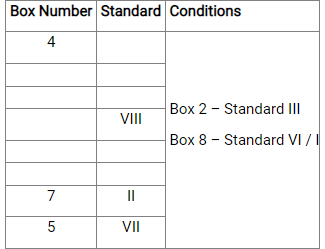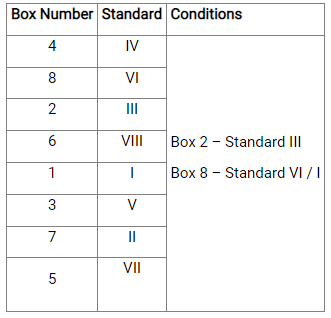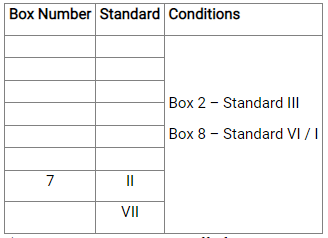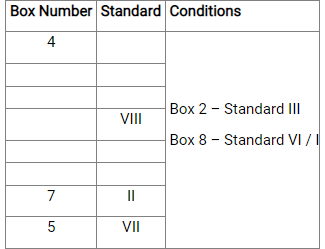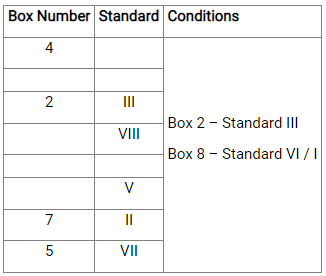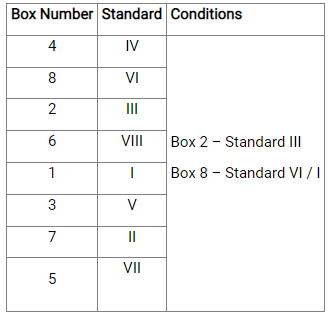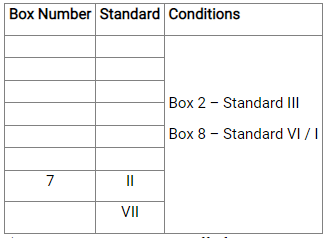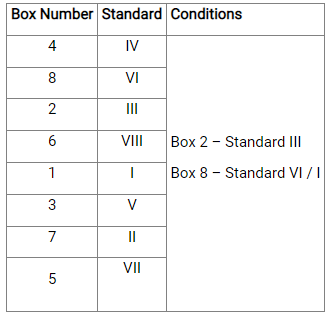IBPS RRB Clerk Mains Mock Test - 2 - Bank Exams MCQ
30 Questions MCQ Test - IBPS RRB Clerk Mains Mock Test - 2
Direction: In the following questions, the symbols +, !, @, # and = are used with the following meaning as illustrated below:
‘C + D’ means ‘C is neither greater than nor equal to D’.
‘C ! D’ means ‘C is neither smaller than nor greater than D’.
‘C @ D’ means ‘C is greater than D’.
‘C # D’ means ‘C is not greater than D’.
‘C = D’ means ‘C is either greater than or equal to D’.
Now in each of the following questions assuming the given statements to be True, find which of the conclusion/s given below them is/are definitely True?
Statements:
P = M, Y + B, M + O, T = P, Y # T
Conclusions:
I. T @ M
II. B + T
III. T ! M
Direction: In the following questions, the symbols +, !, @, # and = are used with the following meaning as illustrated below:
‘C + D’ means ‘C is neither greater than nor equal to D’.
‘C ! D’ means ‘C is neither smaller than nor greater than D’.
‘C @ D’ means ‘C is greater than D’.
‘C # D’ means ‘C is not greater than D’.
‘C = D’ means ‘C is either greater than or equal to D’.
Now in each of the following questions assuming the given statements to be True, find which of the conclusion/s given below them is/are definitely True?
Statements:
P + Q, V @ T, Q = T, V @ W, U = W
Conclusions:
I. W + V
II. Q @ V
III. V ! W
Direction: In the following questions, the symbols +, !, @, # and = are used with the following meaning as illustrated below:
‘C + D’ means ‘C is neither greater than nor equal to D’.
‘C ! D’ means ‘C is neither smaller than nor greater than D’.
‘C @ D’ means ‘C is greater than D’.
‘C # D’ means ‘C is not greater than D’.
‘C = D’ means ‘C is either greater than or equal to D’.
Now in each of the following questions assuming the given statements to be True, find which of the conclusion/s given below them is/are definitely True?
Statements:
H @ I, K @ M, K = I, L @ M, L ! J
Conclusions:
I. K @ H,
II. J ! M
III. H @ M
Study the following information carefully and answer the questions given below.
A word and number arrangement machine, when given an input, rearrange them by following a particular rule in each step. The following is the illustration of an input and rearrangement.
Input: 97 Chase Mountain 89 Laptop 49 Flow 36 Quality 69
Step 1: 89 97 Mountain Laptop 49 flow 36 quality 69 chase
Step 2: 89 97 Mountain Laptop 49 36 quality 69 chase flow
Step 3: 89 97 69 Mountain 49 36 quality chase flow laptop
Step 4: 89 97 69 49 36 quality chase flow Laptop Mountain
Step 5: 89 97 69 49 36 chase Flow Laptop Mountain Quality
Step V is the last and final step of the given input. By following the same rules, find the steps for the below input and answer the questions given below.
Input: North 24 Leather 68 imaginary world 35 55 antonyms 47
Q. Which of the following element is sixth from the left end of the penultimate step of the given input?
Study the following information carefully and answer the questions given below.
A word and number arrangement machine, when given an input, rearrange them by following a particular rule in each step. The following is the illustration of an input and rearrangement.
Input: 97 Chase Mountain 89 Laptop 49 Flow 36 Quality 69
Step 1: 89 97 Mountain Laptop 49 flow 36 quality 69 chase
Step 2: 89 97 Mountain Laptop 49 36 quality 69 chase flow
Step 3: 89 97 69 Mountain 49 36 quality chase flow laptop
Step 4: 89 97 69 49 36 quality chase flow Laptop Mountain
Step 5: 89 97 69 49 36 chase Flow Laptop Mountain Quality
Step V is the last and final step of the given input. By following the same rules, find the steps for the below input and answer the questions given below.
Input: North 24 Leather 68 imaginary world 35 55 antonyms 47
Q. What is the position of “Imaginary” in the last step of the given input?
Study the following information carefully and answer the questions given below.
A word and number arrangement machine, when given an input, rearrange them by following a particular rule in each step. The following is the illustration of an input and rearrangement.
Input: 97 Chase Mountain 89 Laptop 49 Flow 36 Quality 69
Step 1: 89 97 Mountain Laptop 49 flow 36 quality 69 chase
Step 2: 89 97 Mountain Laptop 49 36 quality 69 chase flow
Step 3: 89 97 69 Mountain 49 36 quality chase flow laptop
Step 4: 89 97 69 49 36 quality chase flow Laptop Mountain
Step 5: 89 97 69 49 36 chase Flow Laptop Mountain Quality
Step V is the last and final step of the given input. By following the same rules, find the steps for the below input and answer the questions given below.
Input: North 24 Leather 68 imaginary world 35 55 antonyms 47
Q. How many letters are between the first letter of the second element from the right end and the second letter of the fourth element from the left end in step III of the given input as per the English alphabetical series?
Direction: The question below consists of a question and two statements numbered I and II given below it. You have to decide whether the data provided in the statements are sufficient to answer the question.
Six friends - A, B, C, D, E and F had meeting on either 15th or 18th of three different months – January, March and April. But not necessarily in the same order. Whose meeting is on March 15th?
Statement I: Four people had meeting between E and F. Two people had meeting between B and F, who did not have meeting on January 15th.
Statement II: A had meeting before D and C. D had meeting immediately before C.
Direction: The question below consists of a question and two statements numbered I and II given below it. You have to decide whether the data provided in the statements are sufficient to answer the question.
There is a family of seven members. How is G related to Q?
Statement I: Q is the brother of W, who is married to his wife Z. P is married to Q. D is the niece of W, who has one son and one daughter. G and R are Cousins of D.
Statement II: W is the brother of Q, who is the husband of P. Z is the sister-in-law of Q, whose daughter is D. R is the niece of Q and G is the nephew of Q.
Study the following information carefully and answer the questions given below.
Point M is 16m to the west of point J, which is 6m to the east of A. Point O is 20m to the south of Y, which is 6m to the east of P. Point C is 20m to the north of Point J. Point T is 8m to the east of point C and is 3m to the south of point H. Point K is 26m to the south of Point P. Point Q is 10m south-east of point O and 16m north-east of point K. Point Y is to the north of point C and west of point H and Point Q is to the south of Point T.
Q. What is the shortest distance between points A and O?
Study the following information carefully and answer the questions given below.
Point M is 16m to the west of point J, which is 6m to the east of A. Point O is 20m to the south of Y, which is 6m to the east of P. Point C is 20m to the north of Point J. Point T is 8m to the east of point C and is 3m to the south of point H. Point K is 26m to the south of Point P. Point Q is 10m south-east of point O and 16m north-east of point K. Point Y is to the north of point C and west of point H and Point Q is to the south of Point T.
Q. What is the distance and direction of point J with respect to point Y?
Study the following information carefully and answer the questions given below.
Point M is 16m to the west of point J, which is 6m to the east of A. Point O is 20m to the south of Y, which is 6m to the east of P. Point C is 20m to the north of Point J. Point T is 8m to the east of point C and is 3m to the south of point H. Point K is 26m to the south of Point P. Point Q is 10m south-east of point O and 16m north-east of point K. Point Y is to the north of point C and west of point H and Point Q is to the south of Point T.
Q. Four of the following five are alike in a certain way as per the given arrangement and hence form a group. Which of the following one does not belong to that group?
If it’s possible to make a meaningful word from the 6th, 7th, and 8th letters of the word DOMINANT, then which will be the third letter of the word from the left side? Mark ‘X’ if no such word can be formed, ‘Y’ if more than 1 such word can be formed.
Direction: To answer this question, carefully study the following arrangements of letters, digits, and symbols.
Q C # 2 A 3 M $ F G % 9 1 G A C C S 5 I 8 @ V
How many such symbols are there in the above arrangement, each of which is immediately followed by a number and immediately preceded by a consonant?
Direction: To answer this question, carefully study the following arrangements of letters, digits, and symbols.
Q P 5 # A 7 $ L A L % 2 Q @ 1 A J ? U R 3 * E D
How many such symbols are there in the above arrangement, each of which is immediately preceded by a number and also immediately followed by a vowel?
In the given questions, the relationship between different elements is shown in the statements followed by some conclusions. Find the conclusion which is definitely false.
Statements:
N ≥ T = O ≥ W ≥ A; Q < J < W < P; Q ≥ E ≥ U < I; E < V ≤ A
Conclusions
In the given questions, the relationship between different elements is shown in the statements followed by some conclusions. Find the conclusion which is definitely false.
Statements:
B > C > H = I ≥ T; N > F > D ≥ C; R ≤ X > D = M
Conclusions
In the given questions, the relationship between different elements is shown in the statements followed by some conclusions. Find the conclusion which is definitely false.
Statements:
P < A ≤ R ≤ U; Y ≥ A > S ≥ G; Y ≥ Q > E > T; Q < C > K
Conclusions
Direction: Study the following information carefully to answer the given question.
In a six-letter English word (which may or may not be a meaningful English word), Q is placed between U and S. T is between P and R. P is not placed next to either S or U. R is not placed next to S.
Q. Which of the following is correct with respect to the word/s thus formed?
Direction: Read the instructions carefully and answer the question below:
In the store room of a School, eight boxes numbered 1 to 8 are stacked one above the other but not necessarily in the same order. The stuff related to eight classes Standard I to VIII is kept in these boxes but not necessarily in the same order.
The box at the bottom of the stock contains the stuff of standard VII. The stuff of standard III is kept in the box which is numbered with even prime number. Box numbered 8 contains the stuff of either Standard VI or I. Box numbered 7 contains the stuff of Standard II and is kept immediately above the box which contains the stuff of Standard VII. The box which contains the stuff of standard VIII has kept three boxes above the box that contains the stuff of Standard II. Box numbered 4 is kept at the top of the stack. Only one box is kept between Box numbered 4 and box numbered 2. Two boxes are kept between box 2 the box that contains the stuff of Standard V. The box that contains the stuff of Standard I is kept below the box number 2. Box numbered 5 is kept below the box numbered 7. There are two boxes between box numbered 5 and box numbered 1. Box numbered 6 is kept above the box numbered 3.
Q. How many boxes are kept above box numbered 8?
Direction: Read the instructions carefully and answer the question below:
In the store room of a School, eight boxes numbered 1 to 8 are stacked one above the other but not necessarily in the same order. The stuff related to eight classes Standard I to VIII is kept in these boxes but not necessarily in the same order.
The box at the bottom of the stock contains the stuff of standard VII. The stuff of standard III is kept in the box which is numbered with even prime number. Box numbered 8 contains the stuff of either Standard VI or I. Box numbered 7 contains the stuff of Standard II and is kept immediately above the box which contains the stuff of Standard VII. The box which contains the stuff of standard VIII has kept three boxes above the box that contains the stuff of Standard II. Box numbered 4 is kept at the top of the stack. Only one box is kept between Box numbered 4 and box numbered 2. Two boxes are kept between box 2 the box that contains the stuff of Standard V. The box that contains the stuff of Standard I is kept below the box number 2. Box numbered 5 is kept below the box numbered 7. There are two boxes between box numbered 5 and box numbered 1. Box numbered 6 is kept above the box numbered 3.
Q. Which box contains stuff of standard VIII?
Direction: Read the instructions carefully and answer the question below:
In the store room of a School, eight boxes numbered 1 to 8 are stacked one above the other but not necessarily in the same order. The stuff related to eight classes Standard I to VIII is kept in these boxes but not necessarily in the same order.
The box at the bottom of the stock contains the stuff of standard VII. The stuff of standard III is kept in the box which is numbered with even prime number. Box numbered 8 contains the stuff of either Standard VI or I. Box numbered 7 contains the stuff of Standard II and is kept immediately above the box which contains the stuff of Standard VII. The box which contains the stuff of standard VIII has kept three boxes above the box that contains the stuff of Standard II. Box numbered 4 is kept at the top of the stack. Only one box is kept between Box numbered 4 and box numbered 2. Two boxes are kept between box 2 the box that contains the stuff of Standard V. The box that contains the stuff of Standard I is kept below the box number 2. Box numbered 5 is kept below the box numbered 7. There are two boxes between box numbered 5 and box numbered 1. Box numbered 6 is kept above the box numbered 3.
Q. Four of the following pair follow a pattern thus form a group. Find the pair that does not belong to the group?
Direction: Read the instructions carefully and answer the question below:
In the store room of a School, eight boxes numbered 1 to 8 are stacked one above the other but not necessarily in the same order. The stuff related to eight classes Standard I to VIII is kept in these boxes but not necessarily in the same order.
The box at the bottom of the stock contains the stuff of standard VII. The stuff of standard III is kept in the box which is numbered with even prime number. Box numbered 8 contains the stuff of either Standard VI or I. Box numbered 7 contains the stuff of Standard II and is kept immediately above the box which contains the stuff of Standard VII. The box which contains the stuff of standard VIII has kept three boxes above the box that contains the stuff of Standard II. Box numbered 4 is kept at the top of the stack. Only one box is kept between Box numbered 4 and box numbered 2. Two boxes are kept between box 2 the box that contains the stuff of Standard V. The box that contains the stuff of Standard I is kept below the box number 2. Box numbered 5 is kept below the box numbered 7. There are two boxes between box numbered 5 and box numbered 1. Box numbered 6 is kept above the box numbered 3.
Q. How many boxes are numbered same as the class to which the stuff inside the box belongs?
Each of the questions below consists of a question and two statements numbered I and II given below it. You have to decide whether the data provided in the statements are sufficient to answer the questions:
a) If the data in Statement I alone is sufficient to answer the question, while the data in statement II alone is not sufficient to answer the question.
b) If the data in Statement II alone is sufficient to answer the question, while the data in statement I alone is not sufficient to answer the question.
c) If the data either in Statement I alone or in Statement II alone is sufficient to answer the question.
d) If the data in both Statements I and II together are not sufficient to answer the question.
e) If the data in both Statements I and II together are necessary to answer the question.
Q. What is the code for “Looks” in the coded language?
I. “Athlete related question asked” is coded as “sd fs yu er” and “Question for athlete person” is coded as “ab fs po sd”
II. “Athlete person looks strong” is coded as “sd hj po ks” and “Question looks very critical” is coded as “fs ks rd ja”
Direction: Read the instructions carefully and answer the question below.
In a certain code language:
‘Songs are made fun’ is written as ‘qa ne hu mi’.
‘Play daily for hours’ is written as ‘co le du pa’.
‘Daily listen to songs’ is written as ‘ti mi qe du’.
‘Play listen in fun’ is written as ‘zo ne ti co’.
Q. What does the code 'mi' mean?
Direction: Read the instructions carefully and answer the question below.
In a certain code language:
‘Songs are made fun’ is written as ‘qa ne hu mi’.
‘Play daily for hours’ is written as ‘co le du pa’.
‘Daily listen to songs’ is written as ‘ti mi qe du’.
‘Play listen in fun’ is written as ‘zo ne ti co’.
Q. What could possibly be the code for ‘happy hours’?
Direction: Read the instructions carefully and answer the question below.
In a certain code language:
‘Songs are made fun’ is written as ‘qa ne hu mi’.
‘Play daily for hours’ is written as ‘co le du pa’.
‘Daily listen to songs’ is written as ‘ti mi qe du’.
‘Play listen in fun’ is written as ‘zo ne ti co’.
Q. What is the code for the word ‘listen’?
Direction: Read the instructions carefully and answer the question below.
In a certain code language:
‘Songs are made fun’ is written as ‘qa ne hu mi’.
‘Play daily for hours’ is written as ‘co le du pa’.
‘Daily listen to songs’ is written as ‘ti mi qe du’.
‘Play listen in fun’ is written as ‘zo ne ti co’.
Q. What does the code 'du' represent?
Direction: Read the following information carefully and answer the questions that follow:
Six persons namely Ram, Rakesh, Ramesh, Roja, Rekha, and Rajan are getting different salaries but not necessarily in the same order. Rekha gets more than Roja and Rajan. Ram gets Rs 5,000 more than Roja. Ramesh gets more than Rajan, who gets the least salary. The highest salary getting person gets Rs 50,000. Ram gets less than Rekha, who is not the highest salary getting person. Roja gets more than Rakesh and gets Rs 15,000.
Q. Who gets second lowest salary?
Direction: Read the following information carefully and answer the questions that follow:
Six persons namely Ram, Rakesh, Ramesh, Roja, Rekha, and Rajan are getting different salaries but not necessarily in the same order. Rekha gets more than Roja and Rajan. Ram gets Rs 5,000 more than Roja. Ramesh gets more than Rajan, who gets the least salary. The highest salary getting person gets Rs 50,000. Ram gets less than Rekha, who is not the highest salary getting person. Roja gets more than Rakesh and gets Rs 15,000.
Q. How many persons gets salary more than Roja?
If the first and second letters in the word 'ALARMCLOCK' are interchanged, also the third and the fourth letters, the fifth and the sixth letters and so on, which of the following would be the eighth letter from the right?



